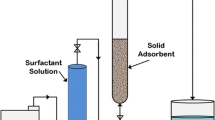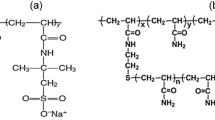Abstract
This proof of concept research evaluates the performance of a surfactant/β-cyclodextrin (β-CD) inclusion complex during chemical flooding for enhanced oil recovery. It was hypothesized that the encapsulated surfactant propagates well through the porous media. Sodium dodecyl sulfate (SDS) was used to study the surfactant/β-CD complexations. Phase behavior analysis was carried out to prepare the most favorable chemical slug formulation. A series of core flooding tests were conducted to determine the efficiency of the SDS/β-CD inclusion complex in displacing residual oil. Surfactant flooding was conducted as tertiary oil recovery mode (after mature water flooding) by injecting 0.3 pore volume (PV) of the optimum surfactant slug that was chased by 0.3 PV of a polymer slug; followed by continuous water flooding until oil production stopped. The experimental results indicate that the encapsulated surfactant propagates well through the sandpack system and consistently produces higher incremental oil recoveries that range from 40 to 82 % over the incremental oil recovery achieved by conventional surfactant flooding.






Similar content being viewed by others
Abbreviations
- k :
-
Permeability in md (millidarcy)
- S or :
-
Residual oil saturation in fraction
- t :
-
Time
- u :
-
Flux in cm/h
- V sm :
-
Surfactant volume in the microemulsion phase
- V wm :
-
Water volume in the microemulsion phase
- V om :
-
Oil volume in the microemulsion phase
- σ mw :
-
Interfacial tension (IFT) between the microemulsion/water phases
- σ mo :
-
Interfacial tension (IFT) between the microemulsion/oil phases
- ϕ :
-
Porosity
References
Zheng L, Yoon S, Ronan AD (2012) Remediation of gasoline contaminated soil using surfactant enhanced aquifer remediation (SEAR). World Environ Water Resour Congress 2012:136–145
Larry L (1989) Enhanced Oil Recovery. Prentice Hall, New Jersey, pp 361–371
Green DW, Willhite GP (1998) Enhanced oil recovery. Society of Petroleum Engineers Richardson, Texas
Jakobsen SR, Hovland F (1994) Surfactant flooding: technical and economical conditions to succeed. In: SPE/DOE improved oil recovery symposium. Society of Petroleum Engineers
Puerto M, Hirasaki GJ, Miller CA, Barnes JR (2012) Surfactant systems for EOR in high-temperature, high-salinity environments. Soc Pet Eng J 17:11–19
Lu J, Weerasooriya UP, Pope GA (2014) Investigation of gravity-stable surfactant floods. Fuel 124:76–84
Haiyang YU, Yefei W, Zhang Y, Zhang P, Wuhua C (2011) Effects of displacement efficiency of surfactant flooding in high salinity reservoir: interfacial tension, emulsification, adsorption. Adv Pet Explor Dev 1:32–39
Salager JL, Manchego L, Márquez L, Bullón J, Forgiarini A (2014) Trends to attain a lower interfacial tension in a revisited pure alkyl polyethyleneglycol surfactant–alkane–water ternary system basic concepts and straightforward guidelines for improving performance in enhanced oil recovery formulations. J Surfactants Deterg 17:199–213
Salager JL, Forgiarini AM, Bullón J (2013) How to attain ultralow interfacial tension and three-phase behavior with surfactant formulation for enhanced oil recovery: a review. Optimum formulation for simple surfactant–oil–water ternary systems. J Surfactants Deterg 16:449–472
Salager JL, Forgiarini AM, Márquez L, Manchego L, Bullón J (2013) How to attain an ultralow interfacial tension and a three-phase behavior with a surfactant formulation for enhanced oil recovery: a review. Performance improvement trends from Winsor’s premise to currently proposed inter-and intra-molecular mixtures. J Surfactants Deterg 16:631–663
Lai N, Zhang X, Ye Z, Li X, Li Z, Wen Y, Zhang Y (2014) Laboratory study of an anti-temperature and salt-resistance surfactant-polymer binary combinational flooding as EOR chemical. J Appl Polym Sci 131:1–9
Hirasaki G, Miller CA, Puerto M (2011) Recent advances in surfactant EOR. SPE J 16:889–907
Flaaten A, Nguyen QP, Pope GA, Zhang J (2009) A systematic laboratory approach to low-cost, high-performance chemical flooding. SPE Reservoir Eval Eng 12:713–723
Elhag AS, Chen Y, Chen H, Reddy PP, Cui L, Worthen AJ, Johnston KP (2014) Switchable amine surfactants for stable CO2/brine foams in high temperature, high salinity reservoirs. In: SPE improved oil recovery symposium. Society of Petroleum Engineers, pp 1−11
Parida SK, Dash S, Patel S, Mishra BK (2006) Adsorption of organic molecules on silica surface. Adv Colloid Interface Sci 121:77–110
Muherei MA, Junin R, Merdhah ABB (2009) Adsorption of sodium dodecyl sulfate, Triton X100 and their mixtures to shale and sandstone: a comparative study. J Pet Sci Eng 67:149–154
Paria S, Khilar KC (2004) A review on experimental studies of surfactant adsorption at the hydrophilic solid–water interface. Adv Colloid Interface Sci 110:75–95
Zhang R, Somasundaran P (2006) Advances in adsorption of surfactants and their mixtures at solid/solution interfaces. Adv Colloid Interface Sci 123:213–229
Somasundaran P, Snell ED, Xu Q (1991) Adsorption behavior of alkylarylethoxylated alcohols on silica. J Colloid Interface Sci 144:165–173
Rodriguez-Cruz MS, Sanchez-Martin MJ, Sanchez-Camazano M (2005) A comparative study of adsorption of an anionic and a non-ionic surfactant by soils based on physicochemical and mineralogical properties of soils. Chemosphere 61:56–64
Rao P, He M (2006) Adsorption of anionic and nonionic surfactant mixtures from synthetic detergents on soils. Chemosphere 63:1214–1221
Baviere M, Bazin B, Aude R (1983) Calcium effect on the solubility of sodium dodecyl sulfate in sodium chloride solutions. J Colloid Interface Sci 92:580–583
Dang CTQ, Chen ZJ, Nguyen NTB, Bae W, Phung TH (2011) Development of isotherm polymer/surfactant adsorption models in chemical flooding. In: SPE Asia Pacific oil and gas conference and exhibition. Society of Petroleum Engineers, pp 1−10
Trogus FJ, Sophany T, Schechter RS, Wade WH (1977) Static and dynamic adsorption of anionic and nonionic surfactants. SPE J 17:337–344
Zhang J, Nguyen QP, Flaaten AK, Pope GA (2009) Mechanisms of enhanced natural imbibition with novel chemicals. SPE Reservoir Eval Eng 12:912–920
Raney KH, Ayirala S, Chin RW, Verbeek P (2012) Surface and subsurface requirements for successful implementation of offshore chemical enhanced oil recovery. SPE Prod Oper 27:294–305
Gupta R, Mohanty KK (2010) Temperature effects on surfactant-aided imbibition into fractured carbonates. SPE J 15:588–597
Levitt D, Jackson A, Heinson C, Britton LN, Malik T, Dwarakanath V, Pope GA (2009) Identification and evaluation of high-performance EOR surfactants. SPE Reservoir Eval Eng 12:243–253
Loftsson T, Masson M (2001) Cyclodextrins in topical drug formulations: theory and practice. Int J Pharm 225:15–30
Loftsson T, Jarho P, Masson M, Järvinen T (2005) Cyclodextrins in drug delivery. Expert Opin Drug Delivery 2:335–351
Bergeron RJ (1984) Cycloamylose-substrate binding. Inclusion Compd 3:391–443
Connors KA (1997) The stability of cyclodextrin complexes in solution. Chem Rev 97:1325–1358
Del Valle EM (2004) Cyclodextrins and their uses: a review. Process Biochem 39:1033–1046
Zou C, Wu H, Ma L, Lei Y (2011) Preparation and application of a series of novel anionic acrylamide polymers with cyclodextrin sides. J Appl Polym Sci 119:953–961
Zou C, Zhao P, Ge J, Lei Y, Luo P (2012) β-Cyclodextrin modified anionic and cationic acrylamide polymers for enhancing oil recovery. Carbohydr Polym 87:607–613
Liao WJ, Zou CJ, Lei Y (2008) Reduction of clay adsorption of cetyl trimethyl ammonium bromide by inclusion complexation. Oilfield Chem 25:74–76
Kittisrisawai S (2014) Novel surfactant delivery system: the solution to surfactant adsorption onto rock formations during enhanced oil recovery chemical flooding (Ph.D. Dissertation). University of New Brunswick, Fredericton. Canada
Ye M, Han D, Shi L (1996) Studies on determination of molecular weight for ultrahigh molecular weight partially hydrolyzed polyacrylamide. J Appl Polym Sc 60:317–322
Sheng J (2010) Modern chemical enhanced oil recovery: theory and practice. Gulf Professional Publishing, MA, USA, p 617
Nishimi T (2008) The formation of middle-phase microemulsions of polar oils. In: macromolecular symposia, Wiley-Vch Verlag 270:48–57
Kahlweit M (1995) How to prepare microemulsions at prescribed temperature, oil, and brine. J Phys Chem 99:1281–1284
Van Brakel J (1975) Pore space models for transport phenomena in porous media review and evaluation with special emphasis on capillary liquid transport. Powder Technol 11:205–236
Zaitoun A, Kohler N (1988) Two-phase flow through porous media: effect of an adsorbed polymer layer. In: SPE annual technical conference and exhibition. Society of Petroleum Engineers
Mohanty KK, Salter SJ (1982) Multiphase flow in porous media: II. Pore-level modeling. (No. CONF-820927-) Arco Oil and Gas Co
Civan F (2001) Scale effect on porosity and permeability: kinetics, model, and correlation. AIChE J 47:271–287
Seright RS, Fan T, Wavrik K, Wan H, Gaillard N, Favéro C (2011) Rheology of a new sulfonic associative polymer in porous media. SPE Reservoir Eval Eng 14:726–734
Hirasaki GJ, Pope GA (1974) Analysis of factors influencing mobility and adsorption in the flow of polymer solution through porous media. SPEJ 14:337–346
Chauveteau G (1982) Rodlike polymer solution flow through fine pores: influence of pore size on rheological behavior. J Rheol 26:111–142
Loftsson T, Masson M, Brewster ME (2004) Self-association of cyclodextrins and cyclodextrin complexes. J Pharm Sci 93:1091–1099
Acknowledgments
The technical assistance of Miss Amanda Floriani from the Universidade Federal de Santa Catariana, Brazil, during the execution of the phase behavior analysis and interfacial tension measurements is greatly appreciated. The authors also acknowledge the financial support provided to this research by the Department of Chemical Engineering, University of New Brunswick, the Natural Sciences and Engineering Research Council of Canada (NSERC), and the Canadian Foundation for Innovation (CFI).
Author information
Authors and Affiliations
Corresponding author
About this article
Cite this article
Kittisrisawai, S., Romero-Zerón, L.B. Complexation of Surfactant/β-Cyclodextrin to Inhibit Surfactant Adsorption onto Sand, Kaolin, and Shale for Applications in Enhanced Oil Recovery Processes. Part III: Oil Displacement Evaluation. J Surfact Deterg 18, 797–809 (2015). https://doi.org/10.1007/s11743-015-1692-8
Received:
Accepted:
Published:
Issue Date:
DOI: https://doi.org/10.1007/s11743-015-1692-8




